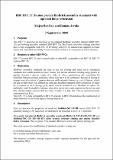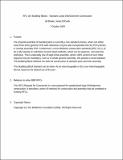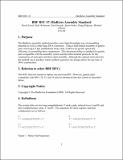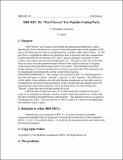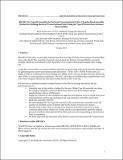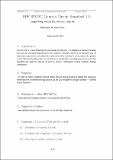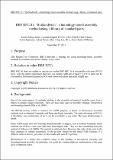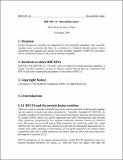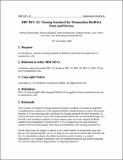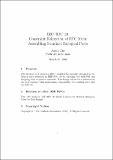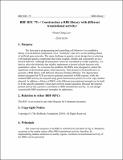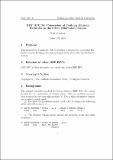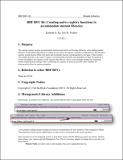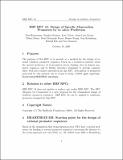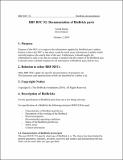Browsing Requests for Comments (RFCs) by Title
Now showing items 17-36 of 74
-
BBF RFC 37: Fusion protein BioBrick assembly standard with optional linker extension
(2009-09-02)This RFC 37 describes an extension of the original BioBrick assembly standard (BBF RFC 10) and Freiburg assembly standard (BBF RFC 25). The Fusion Assembly strategy described here is fully compatible with RFC 25 (Freiburg) ... -
BBF RFC 38: RFC 38: Building Blocks - Standard Large DNA/Genome Construction
(2009-10-07)The physical assembly of standard parts is currently a non-standard process, which can either come from direct genome PCR with restriction enzyme sites incorporated into the PCR primers, or overlap assembly PCR. ... -
BBF RFC 47: BioBytes Assembly Standard
(2009-10-29)The BioBytes assembly method provides a new high-throughput way of assembling plasmids as well as other large DNA constructs. Using a bead-linked assembly of genetic parts with long (12 bp) standardized sticky ends, ... -
BBF RFC 56: “Part Flavors” For Peptide-Coding Parts
(2010-10-11)“Part Flavors” are a means of describing the grammatical properties of parts. Specifically, this is introduced as a means of describing parts that encode peptides (CDS parts), but there may be value to extrapolating the ... -
BBF RFC 94: Type IIS Assembly for Bacterial Transcriptional Units: A Standardized Assembly Method for Building Bacterial Transcriptional Units Using the Type IIS Restriction Enzymes BsaI and BbsI
(2015-08-28)This RFC94 describes an assembly standard based on the Type IIS restriction enzymes BsaI and BbsI (also called BpiI). This assembly standard is based upon the Modular Cloning (MoClo) assembly strategy, which was introduced ... -
BBF RFC97: Genetic Circuit Standard 1.0
(2013-10-29)Current, there is well adopted documentation of biobricks. The Registry of Standard Biology Part set the standard documentation for biobrick. However, there is no standard way to document a genetic circuit, what information ... -
"BioSandwich", a homology-based assembly method using a library of standard parts
(2011-10-17)This Request for Comments (RFC) describes a strategy for using homology-based assembly methods to assemble parts from a library in any order. -
Bioscaffold-Linker
(2009-10-21)Protein fusions are currently not supported by most assembly standards. This assembly standard aims to provide the basis of a solution to a biobrick-friendly protein fusion mechanism that supports the current favorite ... -
Building Protein Domain Based Composite Biobricks for Mammalian Expression Systems
(2010-12-05)The purpose of this RFC is to describe a method that allows the design of protein domain based parts, starting with gene centered information and translate these informations into BBF RFC 25 compatible part. The method is ... -
Cloning Standard for Mammalian BioBrick Parts and Devices
(2009-10-21)To introduce a common cloning standard for BioBrick parts that find application in mammalian cells. -
Constraint Relaxation of RFC 10 for Assembling Standard Biological Parts
(2009-03-30)This Request for Comments (RFC) modifies the assembly standard for biological parts proposed in BBF RFC 10 by replacing PstI with SbfI and dropping other sequence constraints. This change relaxes the constraints on the ... -
Construction a RBS library with different translational activity
(2010-12-05)The first step in programming and controlling cell behavior is to establish a library of well-defined components, a.k.a. "biobricks", that serve as the building blocks of artificial gene networks. The main challenge in ... -
Conversion of Freiburg (Fusion) Biobricks to the Silver (BioFusion) format
(2009-03-30)This Request for Comments (RFC) describes a strategy for converting Biobricks from the Freiburg (aka Fusion) format to the Silver lab (aka BioFusion) format. -
Creating native registry functions to accommodate mutant libraries
(2011-12-29)The current registry system accommodates normal parts fairly well but has difficulty when adding mutant libraries. If all mutant offspring were added as new parts, the registry would be comprehensive but the parts registry ... -
Design of Specific Mammalian Promoters by in silico Prediction
(2009-10-30)The purpose of this RFC is to provide a) a method for the design of rational synthetic promoter sequences based on a statistical analysis about the spatial preference of transcription factor binding sites in human promoter ... -
Detailed Information Standard
(2010-12-05)The purpose of this standard is to increase the required information that must accompany any parts submitted to the Registry of Standard Biological Parts. This will give users of the parts better assurance of their ... -
Documentation of BioBrick parts
(2010-12-05)Purpose of this RFC is to improve the information supplied by BioBrick part vendors. Reason to have this RFC is that there would be much more information available which can help improve the search time of the user. ... -
Draft Standard for Biobrick BB-2 Biological Parts
(OpenWetWare, 2008-11-19)This standard defines the required sequence properties for a Biobrick(R) BB-2 standard biological part. It does not define any functional characteristics of the parts, nor does it motivate any aspect of these standards. -
Draft Standard for Biobrick Biological Parts
(OpenWetWare, 2007-05-03)This standard defines the required sequence properties for a Biobrick(tm) standard biological part. It does not define any functional characteristics of the parts, nor does it motivate any aspect of these standards. ... -
DTU Synthetic Promoter Library Standard
(2010-12-04)The purpose of this RFC is to outline a method for generating a BioBrick compatible Synthetic Promoter Library (SPL) within bacteria in order to fine-tune the expression of BioBrick parts and devices.
